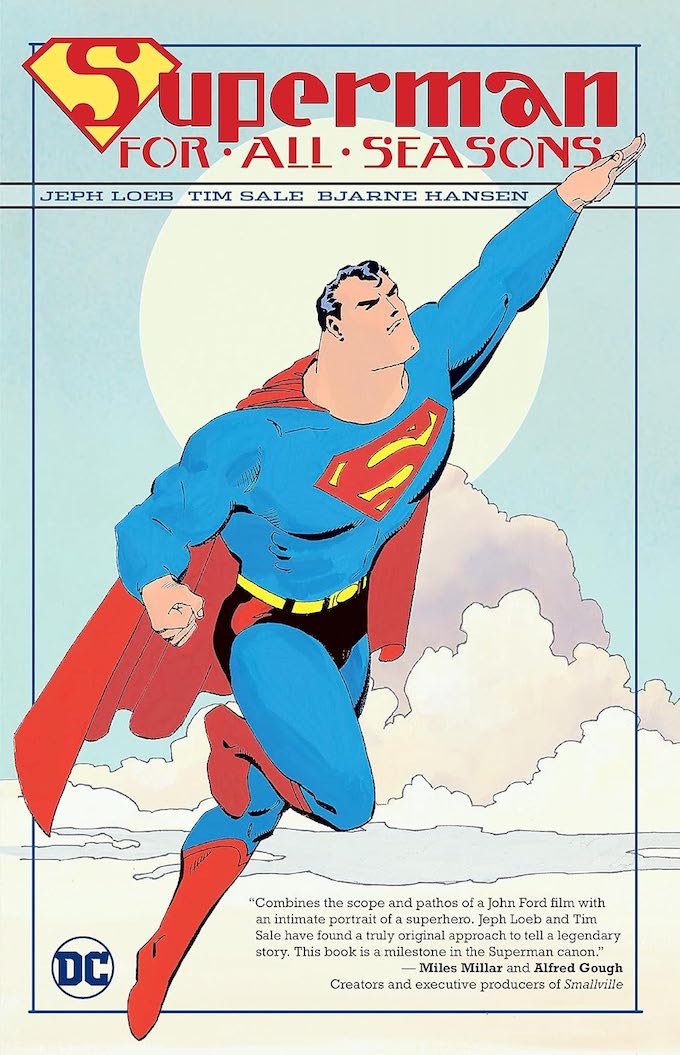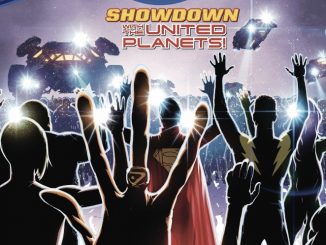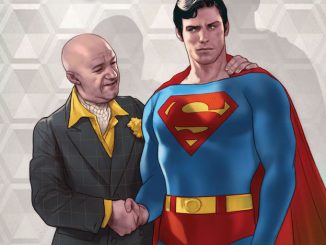
Superman: For All Seasons
Writer: Jeph Loeb
Artist: Tim Sale
Cover: Tim Sale
Reviewed by: Craig Boehmer
Superman: For All Seasons is a collection that has drawn praise from many fans and critics. It has been lauded as a tightly narrated, emotionally resonant, beautiful analysis of the Man of Steel’s early days. Indeed, it pops up frequently on lists of best Superman stories of all times and has formed the spiritual basis of the long running “Smallville” TV series. It has returned to the limelight in response to James Gunn posting multiple pictures hinting that his upcoming “Superman: Legacy” would also be inspired by Jeph Loeb’s work. Fortuitously DC released a beautiful Absolute Edition collecting the four issues, the beautiful artwork prompted me to order it and impatiently await its’ arrival in the mail. When I finally received it, and got the opportunity to reacquaint myself with it, I was moved by its’ simplicity and sincerity. For those that don’t know, Superman: For All Seasons was written by Jeph Loeb, with pencils by Tim Sale, and colors by Bjarne Hansen. It was originally published as four issues through 1998.
The story is broken up into four chapters, each coinciding with a Season. The first chapter is titled “Spring” and is told from the perspective of Johnathan Kent. Chapter two is “Summer”, told from Lois Lane’s perspective. “Fall” is chapter three, with Luthor as the narrator. And the story wraps up with Lana Lang narrating “Winter”. In broad strokes the story is about Clark deciding to move to Metropolis and his first year as Superman there. He is eventually confronted by Luthor, who develops a plot that “defeats” Superman and causes him to flee back to Smallville. During his time back in Smallville, he uses his powers to help avert a major flood, and rediscovers himself as a hero.
While the story and characterization are great. It is the artwork that solidifies this as one of the best Superman stories. Tim Sale took a drastically different approach to this when compared to his Batman work. Whereas his Batman is horror gothic, drawn to look like a spiritual continuation of Frank Miller and David Mazzuchelli’s “Batman: Year One”. He understood when taking on this project, that in Batman’s world he could often use shadows to cover weak pencils, but on Superman the world is bright and vibrant. The brightness of Superman’s world shows the vulnerability of the artist’s work, there is nowhere to hide. Overall, he rose to the occasion of Superman. He was very open about how he attempted to replicate the feeling of Norman Rockwell’s artwork. His artwork is filled with nostalgic Americana, especially his depiction of Smallville. It is beautifully illustrated as the typical, prosperous midwestern town. There are no signs of decay, addiction, or economic depression in Sale’s Smallville. It is the Apple Pie of his comic book art. Metropolis, likewise, is designed as a beacon of human ingenuity and unabashed desire to achieve. It is an awe-inspiring city of tomorrow.
Tim Sale’s character design for Superman takes some getting used to. He doesn’t depict Superman as a model, or as a muscle-bound body builder. Instead, Sale’s Superman, and Clark, are walking behemoths. Clark looks like a corn-fed farm kid who grew up eating midwestern food and working his whole life on the farm. While I do not think this should be the design for Superman in every medium, for this story it is great. As part of that character design though, he maintains a distinct nod towards the original Shuster design of the character. This is seen in how he pencils Superman’s face; he has the squinty eyes that characterized Shuster’s work. It makes for a nice nod towards Superman’s real-world first appearance and creates continuity between the two.
We can’t talk about the art in this book without touching on the colorist. Bjarne Hansen provided beautiful colors in this book. It is unlikely that Sale’s art would have evoked the charm it does, without Hansen’s watercolors. It is a gorgeously colored book. The colors add to the depth of Americana that the book evokes. In the introduction to the book Loeb recounts that Tim Sale specifically requested Bjarne Hansen be the one to colour this book. Sale admitted that he would purposefully leave large swaths of the background blank so that Hansen could be more creative with his colours. This was most noticeable in the scene right before Clark leaves Smallville the first time. While in a field with his Pa he asks if he ever gets tired of the view. Pa admits he hasn’t, and doesn’t think he ever will. Bjarne Hansen paints one of the most beautiful landscapes of a sunrise I have ever seen. The colours explode from the page in intense pinks, oranges, yellows, and reds which mingle together to create an awe-inspiring background that demands to be seen in the largest format available. For this reason, I bit the bullet and purchased this collection as my first ever Absolute Edition.
While the art is beautiful, a comic needs to have a great characterization of Superman to be considered one of the all-time greats. This collection is a wonderful example of how to write Clark and his supporting cast. I only want to discuss Clark and Luthor. There are many characters worth analyzing in this work, but due to space constraints I will limit it to these two.
At the beginning of the story Clark shows very little inclination towards leaving the farm. He is shown gradually developing his powers through day to day activities. While getting a haircut he accidentally sees through the wall to where Pete and Lana are chatting, the scissors also break on his hair. While on the farm he casually lifts a massive boulder out of the ground while helping his dad. We get to glimpse this transition time where he begins to understand how different he is. Clark must then address the question, “What should I do?” When a tornado rips through the town and he witnesses the extensive damage wrought by the tornado, he decides that he must help people. This becomes his purpose in life, to help people in any way he can. He only saved one person from the tornado, and this propels him on his journey to save as many as he can throughout his life. His ideal of using his powers to save people is born.
Clark goes through the most significant growth in this story. He initially goes to Metropolis with an idealized sense of what he can do, through Luthor’s sinister machinations Clark feels emotionally defeated and is forced to challenge his own ideas of what he can do. Clark regularly retreats to his parents’ farm throughout the story, it is his Fortress of Solitude. When he experiences the perceived defeat of his ideals, he retreats there again to be healed by his parents’ love. When he returns to Metropolis the final time, he is the Superman we know and love.
Luthor is portrayed as a vindictive business tycoon very much in line with his depiction since the Byrne relaunch. Early in the story Pete Ross exclaims his doubt that a person like Luthor even exists. His apparent benevolence to the city is known country wide and he has developed a possessive view of Metropolis. This central conflict between him and Superman portrayed as one similar to a love triangle. He views the city as his love, he owns it, and when Metropolis showers Superman with praise it enrages him as it would a jilted lover. I prefer Luthor to separated from Clark’s experiences in Smallville, to me it creates a better villain/hero dynamic. “Superman: Birthright”, and the “Smallville” TV series really played up the high school relationship between Clark and Lex, and while I enjoyed the dynamic in “Smallville”, I much prefer this version of the Lex and Clark dynamic.
Portraying Lex as the jilted lover, who is jealously possessive over the object of his desire is an interesting take on the character. During one tirade Loeb pulls a quote from “My Fair Lady’s” Professor Henry Higgins to show how Luthor views the city. He states, “I have grown accustomed to her face.” Upon further reflection Luthor really views himself as Higgins does in My Fair Lady. He believes he saved the city and now deserves to possess the city, much the same way that Higgins views Eliza Dolittle. It is a toxic possession that leads him to view Superman as a challenge to his position. He goes so far as to create his own army of heroes to replace Superman and put the spotlight back on him. They are particularly prominent during Superman’s time away from Metropolis. When Superman returns to Metropolis he must first deal with a small crisis Lex’s heroes cause by their carelessness. The Lexbots are a nice nod to Lex’s early response to Superman in the Triangle era of Superman. The story shows Luthor shift from a man who is sure of his place in Metropolis, and his relationship with Lois, to a man who can’t understand how significantly the rules have changed. He cannot fathom the goodness of Superman, just as Superman cannot fully understand the evil of him.
Clark’s growth as an individual is what makes this book so resonant, even over twenty years after the fact. He portrays the widely relevant experience of a young person going out into the world for the first time by themselves. Clark is led by his idealism, never suspecting that he will fail. This central theme is instantly recognizable to anyone who has ever left their own parents’ home. Clark is humanized next to this theme because while we may not have his ideals, we all have some sort of morality code and dreams that propel us forward into adulthood. This is most resonant in the panels showing Clark on his bed in his Metropolis apartment, eating a peanut butter sandwich. He looks miserable and lonely and instantly heads off towards the farm to be with his parents. Who hasn’t had that moment when you first move out of sitting alone in your room, eating whatever is cheap and easy to make, and wishing you could just fly home to experience the simple comforts of your home.
As Clark pushes forward in his goal of using his gifts to help people he encounters the worst in humanity, Lex Luthor. Luthor’s schemes cause Superman to witness the death of an individual he had saved earlier in the story. This conflict with Luthor shows us Clark evolving into a symbol of hope and resilience. Initially this loss profoundly affects him and forces him to recognize that he cannot save everybody, and that not everybody is good. These twin truths are difficult for someone with his power, and his upbringing to reconcile, but in the end the resiliency of his hope wins out and he returns to Metropolis to help people. Much has been written about Superman as a symbol for hope, but this story really hammers down that he cannot become the symbol of hope without embodying the resilient nature of hope. And its not solely about his resilience against overwhelming physical odds, but also the emotional resilience it takes to understand that he will fail to save people, he cannot save Luthor, he could not save the chemist Vaugh/Toxin, and he may not be able to save someone close to him in the future. He learns to accept his limitations without sacrificing the ideal of what he believes, and becomes a stronger and more effective hero because of it.
Through Loeb’s run on Superman in the early 2000s he utilized other characters to act as narrators, reacting to Clark, rather than giving us Clark’s inner thoughts. Loeb first experimented with that here. In the introduction he admits that originally he did not use this narrative strategy, but found the first issue was too brisk a read. He wanted a way to slow the readers down, to let them fully absorb the beautiful art and colors by Sale and Hansen. His letterer and longtime collaborator, Richard Starkings, suggested using the characters around Clark as the narrators. I believe that that single suggestion elevated this story from being just beautiful artwork with a middling story, to becoming an intensely beautiful emotional study of Clark Kent and how those around him view him. The most impactful issues were the ones narrated by Pa Kent, and Lana Lang. My preference has always been that Clark Kent is who is he, and Superman is what he can do. Pa’s and Lana’s narrations allow us to see him in this light. Loeb admits that he filled Pa’s dialogue with things his father had said to him throughout his life. That fills the narration with honesty and sincerity, that I as the reader could feel. In contrast to the Clark centered narrations, Luthor’s and Lois’ musings center on the amazingness of Superman. Luthor’s narration provides us with a great look into how Luthor feels wronged by Superman and betrayed by his city, which adds great depth to their conflict, and also adds layers to the Byrne helmed interactions between Superman and Lex. It is worth noting though that it is Lana’s thoughts of Clark that are used when Loeb depicts his return to Metropolis, I took this to mean that Superman needs his center to be on Clark and the ideals of Smallville in order for him to be an effective hero. Tom King provided a similar take in his “Superman: Up in the Sky”.
Seeing as this is, at its core, a romanticized version of the Superman origins mythos it seems fitting to compare this work to other significant retellings of the Man of Steel’s origin. How does it stack up to other post-crisis origins such as Man of Steel, Birthright, Secret Origins, and the New 52? The first major difference is Superman: For All Seasons is not concerned about continuity or setting up a new status quo. For the most part it does fit nicely into the Byrne continuity, but it is not a slave to it. It feels like all the other major post-crisis origins tried to alter continuity in some way. In Man of Steel Bryne dramatically altered the landscape by bringing the Kents back to life, and having Clark be “born” on earth. He also significantly pruned back the Kryptonians still alive, making Clark the sole surviving Kryptonian. Man of Steel also removed Clark’s history as Superboy, something that was not reversed until Geoff Johns’ Secret Origins. Morrison’s New 52 origin removed the Kents from the picture, creating an environment where Clark’s whole existence is the battle for justice, much more akin to the Golden Age Superman. For All Seasons hints at Clark doing superfeats as a teenager to help people, but there is no secret identity until he goes to Metropolis. Another noticeable feature of For All Seasons, is there is no attempt to provide motivation for Clark’s Superman suit, this frees Loeb up to focus more on Clark’s emotional journey after donning the suit. Birthright creates a world where Lex and Clark were briefly childhood friends, the first to understand and connect with each other, thus leading to a greater tragedy when Lux turns his back on Clark. For All Seasons maintains that Lex and Superman have no interactions until Superman appears in Metropolis. In spite of the changes in continuity, motivations, or childhood friends found in the other origin retellings, I think the largest difference between For All Seasons and these other Post-Crisis Origins is For All Seasons‘ emphasis on the emotions of Clark as he begins his journey. At its core this miniseries is attempting to analyze the emotional toll those initial years as Superman plays on Clark.
Superman: For All Seasons is a beautifully penciled and painted comic book retelling Clark’s transition from farm boy to world recognized superhero. The artwork is incredible, and the characterization is resonant and recognizable. If you are a fan of Superman, you will really enjoy this story. Do yourself a favor and track down the Absolute copy, you deserve to see this art on the largest canvas possible.




